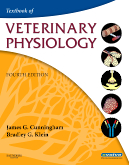|
|
|
| |
 |
|
|

|
 推薦指數:
推薦指數:





|
|
- 內容介紹
|
Textbook of Veterinary Physiology, 4th Edition
By James G. Cunningham, DVM, PhD and Bradley G. Klein, PhD
Approx. 720 pages Approx. 500 illustrations (200 in full color)
Trim size 8 1/2 X 10 7/8 in
Copyright 2007
Description
Now with full-color illustrations, this easy-to-follow text takes the vast subject of physiology and focuses on concepts most important to the practice of veterinary medicine. It includes coverage of physiopathology and clinical problem-solving techniques, making this a practical resource for any practice. The book’s logical, body-system organization makes it easy to find specific information. This edition includes a new chapter on cancer and a new section on the immune system.
Key Features
Expanded information on diabetes mellitus includes the culmination of diabetes, diabetic ketoacidosis, and dietary management of Type 2 diabetes in cats.
Clinical Correlations boxes - increased by 25% in this edition - show how principles and concepts of physiology may be applied to the diagnosis and treatment of veterinary patients.
Summaries of essential points open each chapter, introducing new concepts and helping you prepare for examinations.
Practice questions on the Evolve website make it easy to review for examinations or practice by taking sample exams.
New to this Edition
Cancer and Cell Cycle Control chapter describes the malfunction of the cell involved in neoplasia, essential background to diagnosing and treating cancer in pets.
Immune Function section covers the normal function of the immune system and how it may be affected by autoimmune and immunodeficiency disorders, leading to several types of diseases.
Table of Contents
Section I The Cell
Chapter 1 The Molecular and Cellular Bases of Physiologic Regulation
Chapter 2 Cancer and Cell Cycle Control
Section II Neurophysiology
Chapter 3 Introduction to the Neuromuscular System
Chapter 4 The Neuron
Chapter 5 The Neuromuscluar Synapse
Chapter 6 The Physiology of Muscle
Chapter 7 The Concept of a Reflex
Chapter 8 Skeletal Muscle Stretch Receptors
Chapter 9 The Concept of Lower and Upper Motor Neurons and Their Malfunction
Chapter 10 The Brain’s Control of Posture and Locomotion
Chapter 11 The Vestibular System
Chapter 12 The Cerebellum
Chapter 13 The Autonomic Nervous System and Adrenal Medulla
Chapter 14 The Visual System
Chapter 15 Cerebrospinal Fluid and the Blood-Brain Barrier
Chapter 16 The Electroencephalogram and Sensory Evoked Potentials
Chapter 17 Hearing
Section III Cardiovascular Physiology
Chapter 18 Overview of Cardiovascular Function
Chapter 19 Electrical Activity of the Heart
Chapter 20 The Electrocardiogram
Chapter 21 The Heart as a Pump
Chapter 22 The Systemic and Pulmonary Circulations
Chapter 23 Capillaries and Fluid Exchange
Chapter 24 Local Control of Blood Flow
Chapter 25 Neural and Hormonal Control of Blood Pressure and Blood Volume
Chapter 26 Integrated Cardiovascular Responses
Section IV Gastrointestinal Physiology and Metabolism
Chapter 27 Regulation of Gastrointestinal Function
Chapter 28 Movements of the Gastrointestinal Tract
Chapter 29 Secretions of the Digestive Tract
Chapter 30 Digestion and Absorption: The Nonfermentative Processes
Chapter 31 Digestion: The Fermentative Processes
Chapter 32 Postabsorptive Nutrient Utilization
Section V Endocrinology
Chapter 33 The Endocrine System
Chapter 34 Endocrine Glands and Their Function
Section VI Reproduction and Lactation
Chapter 35 Control of Gonadal and Gamete Development
Chapter 36 Control of Ovulation and the Corpus Luteum
Chapter 37 Reproductive Cycles
Chapter 38 Pregnancy and Parturition
Chapter 39 The Mammary Gland
Chapter 40 Reproductive Physiology of the Male
Section VII Renal Physiology
Chapter 41 Glomerular Filtration
Chapter 42 Solute Reabsorption
Chapter 43 Water Balance
Chapter 44 Acid-Base Balance
Section VIII Respiratory Function
Chapter 45 Overview of Respiratory Function: Ventilation of the Lung
Chapter 46 Pulmonary Blood Flow
Chapter 47 Gas Exchange
Chapter 48 Gas Transport in the Blood
Chapter 49 Control of Ventilation
Chapter 50 Nonrespiratory Functions of the Lung
Section IX Homeostasis
Chapter 51 Fetal and Neonatal Oxygen Transport
Chapter 52 Acid-Base Homeostasis
Chapter 53 Thermoregulation
Section X Immune Function
Chapter 54 Cell, Tissue and Organ Substrates of Immune Function
Chapter 55 Mechanisms of Innate and Acquired Immunity
|
|
|

